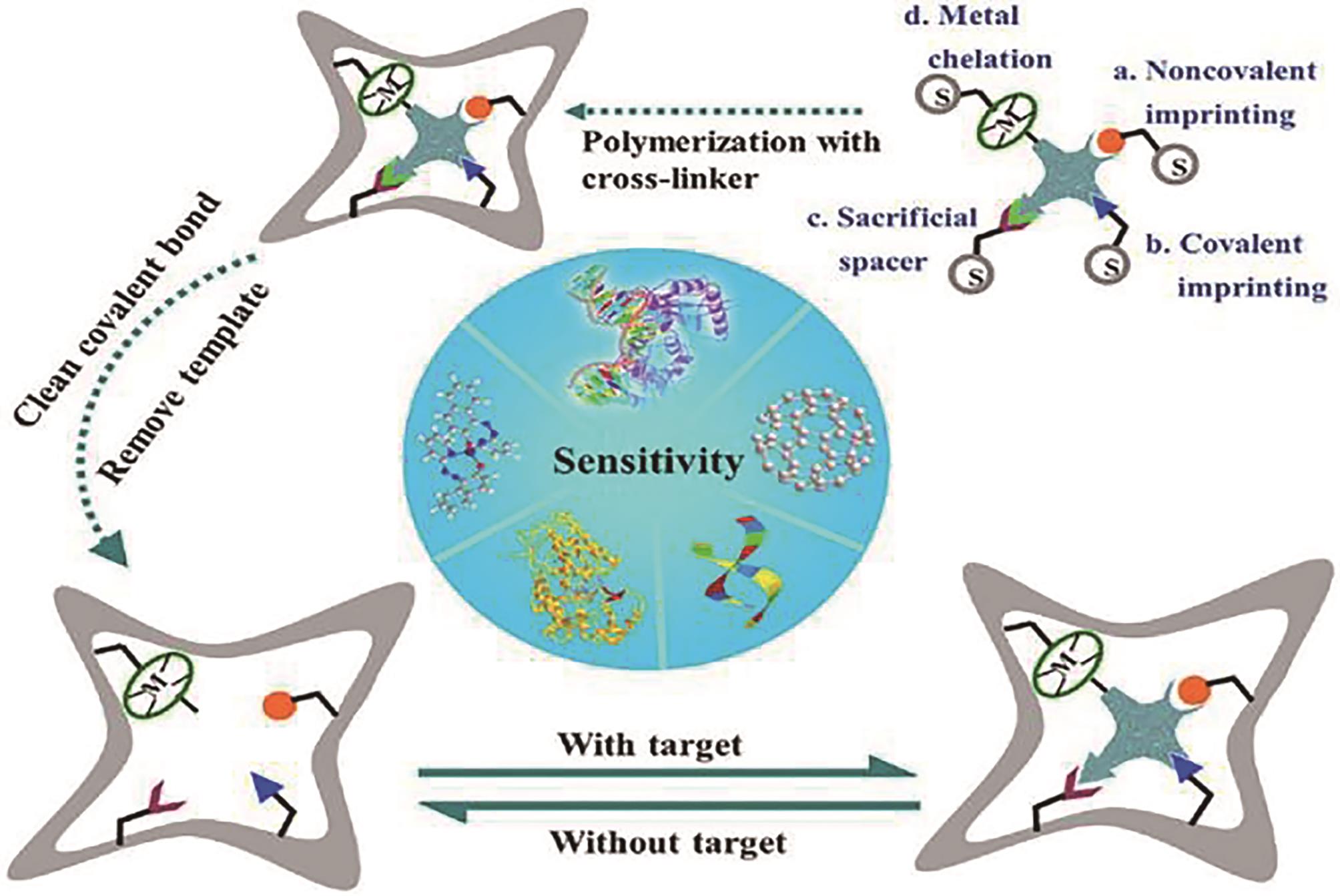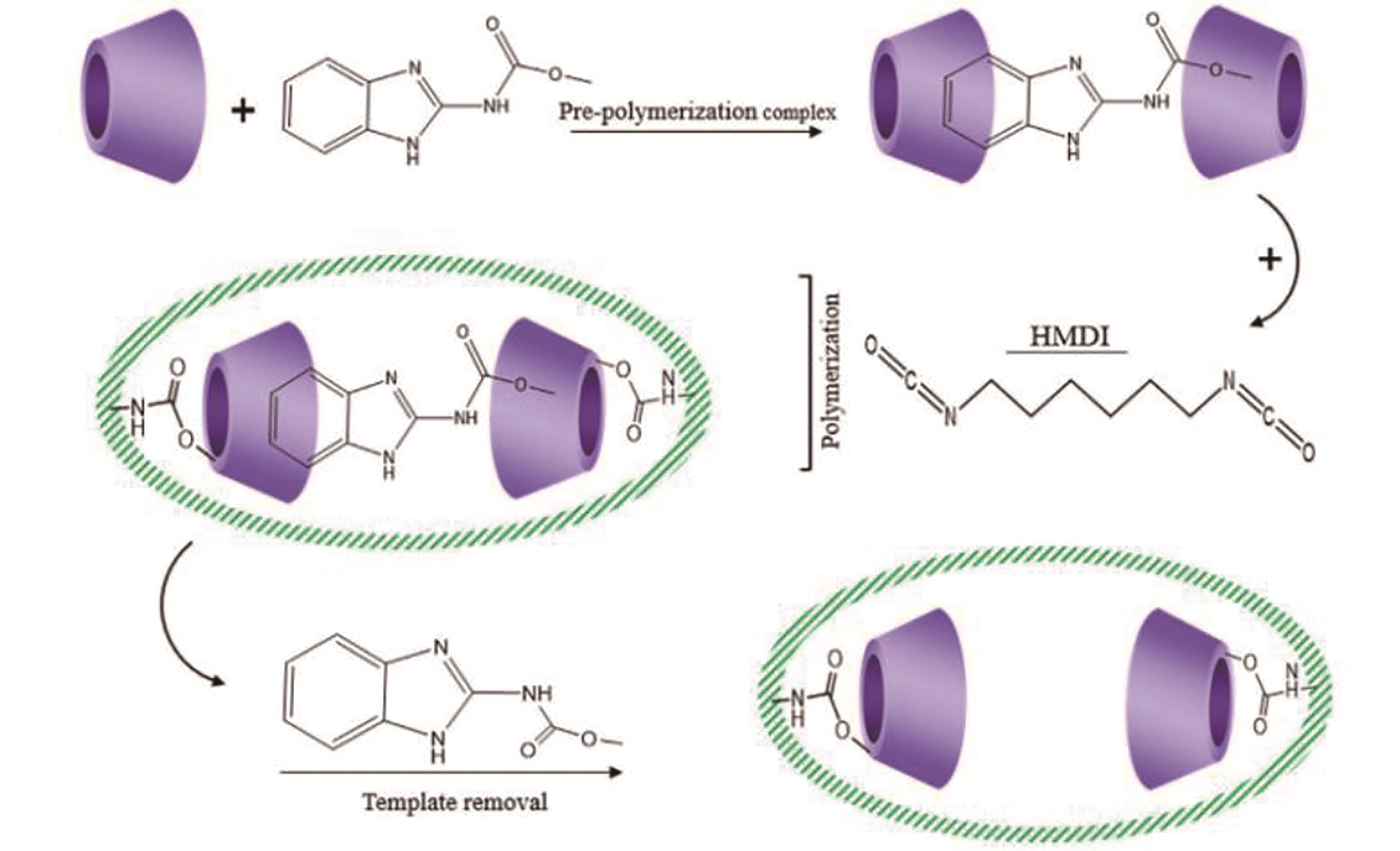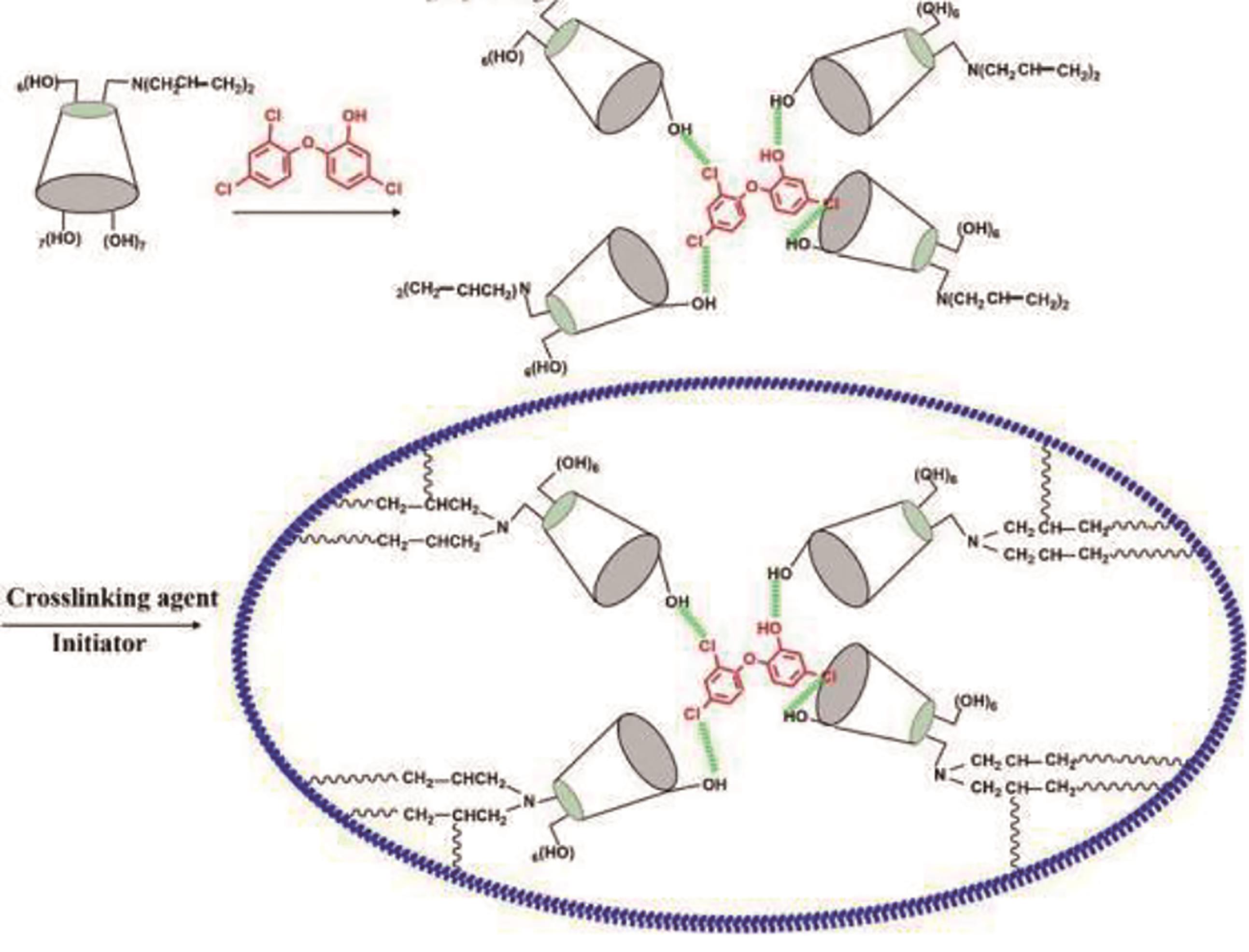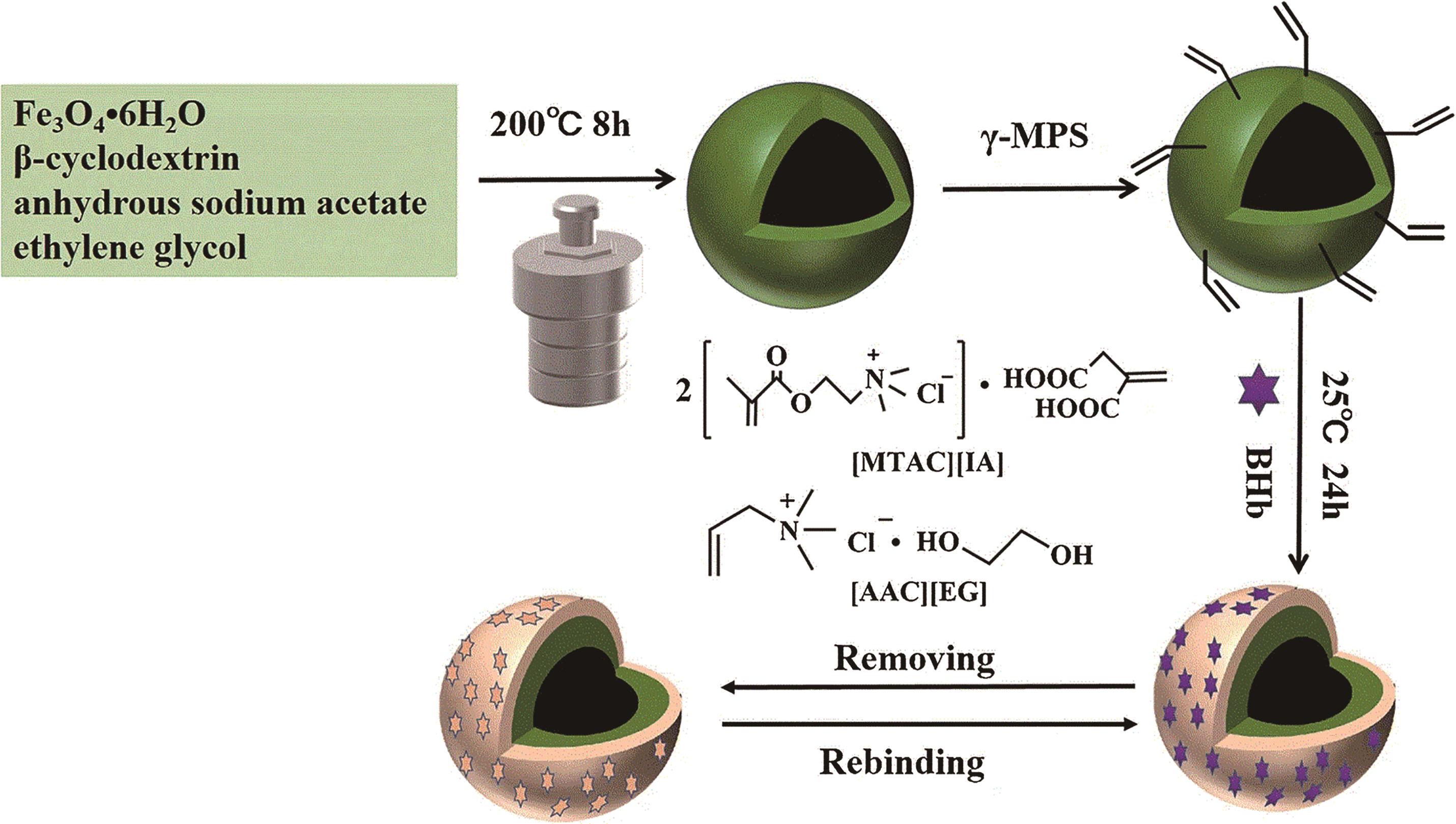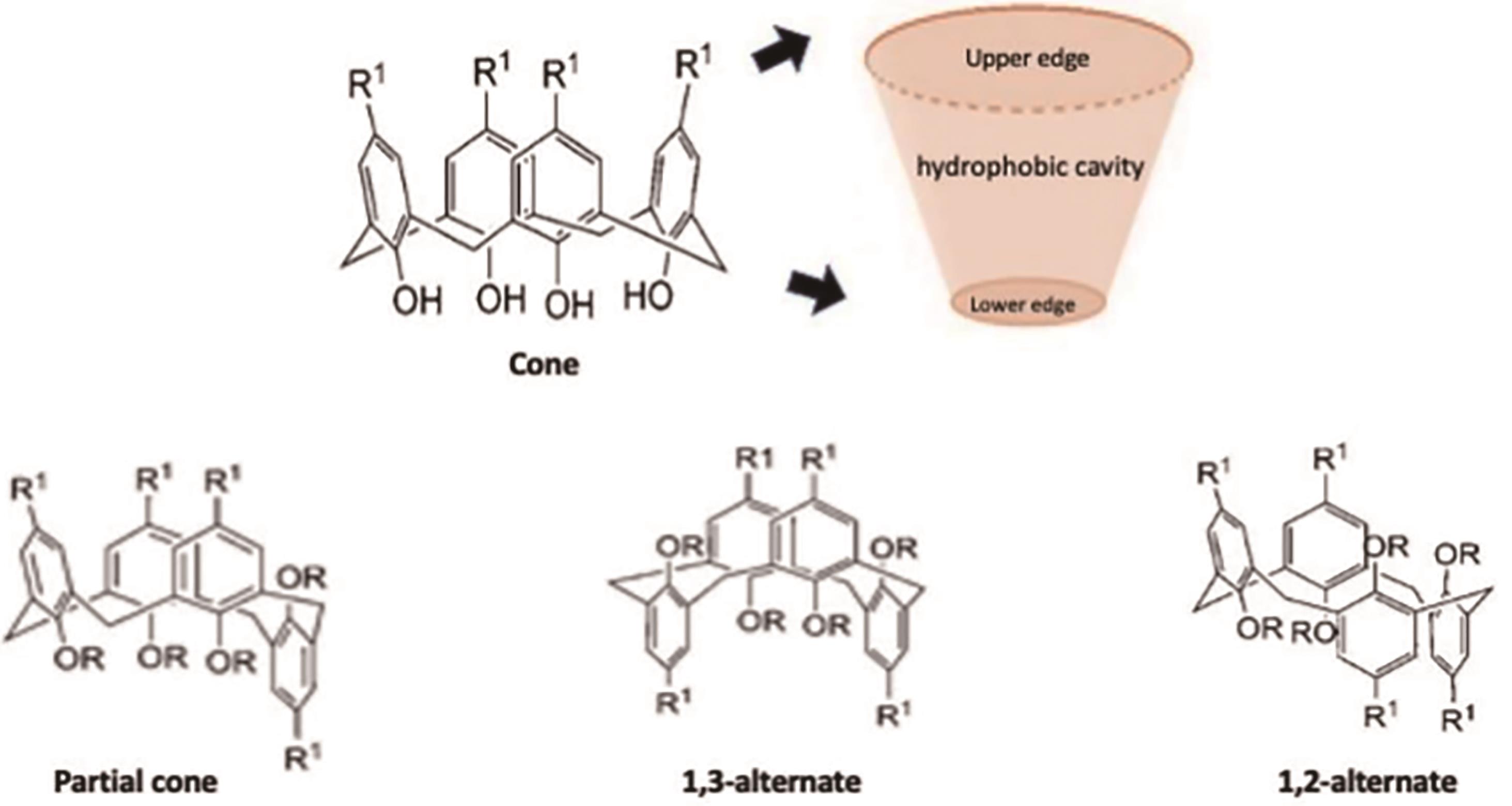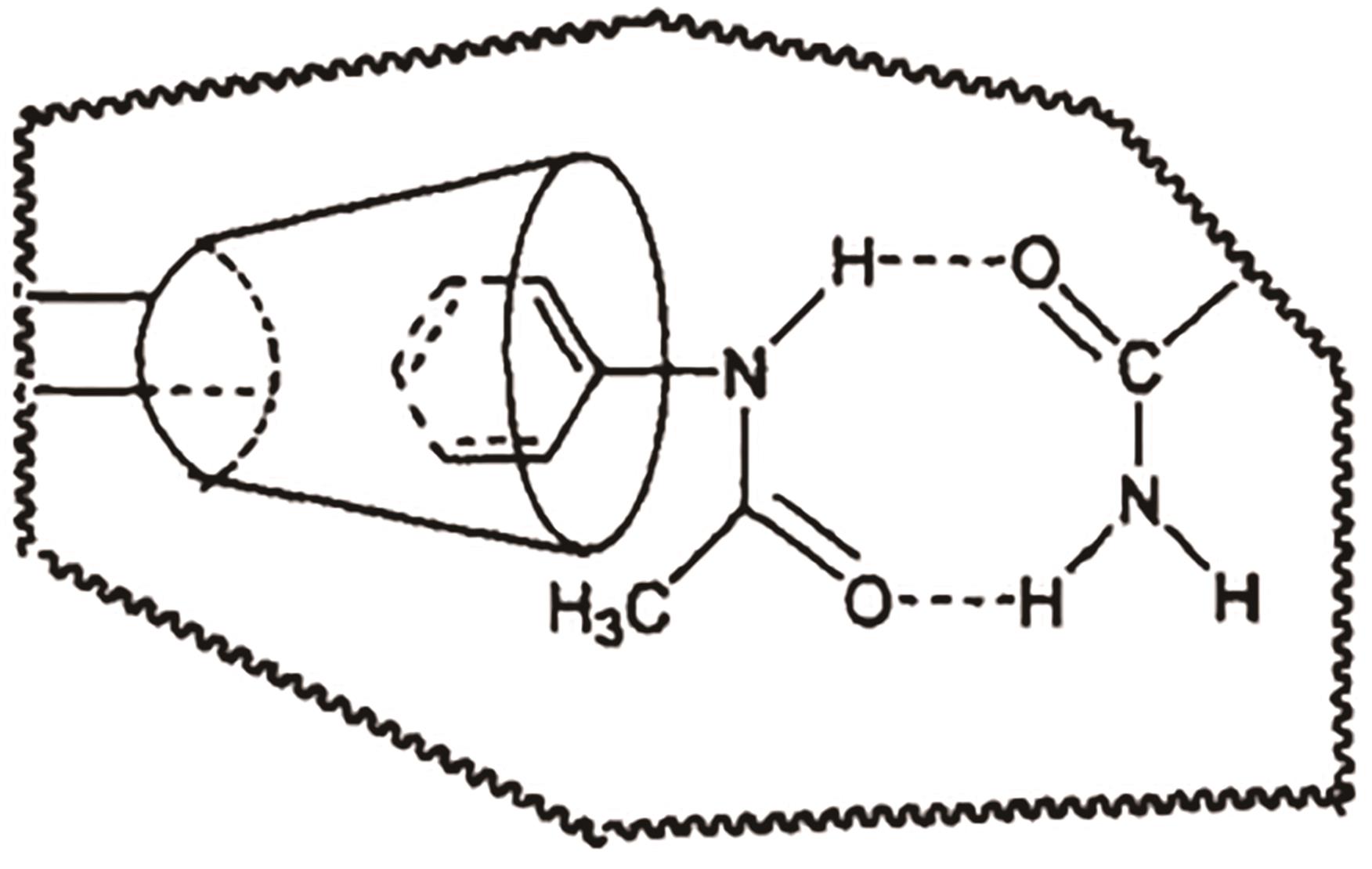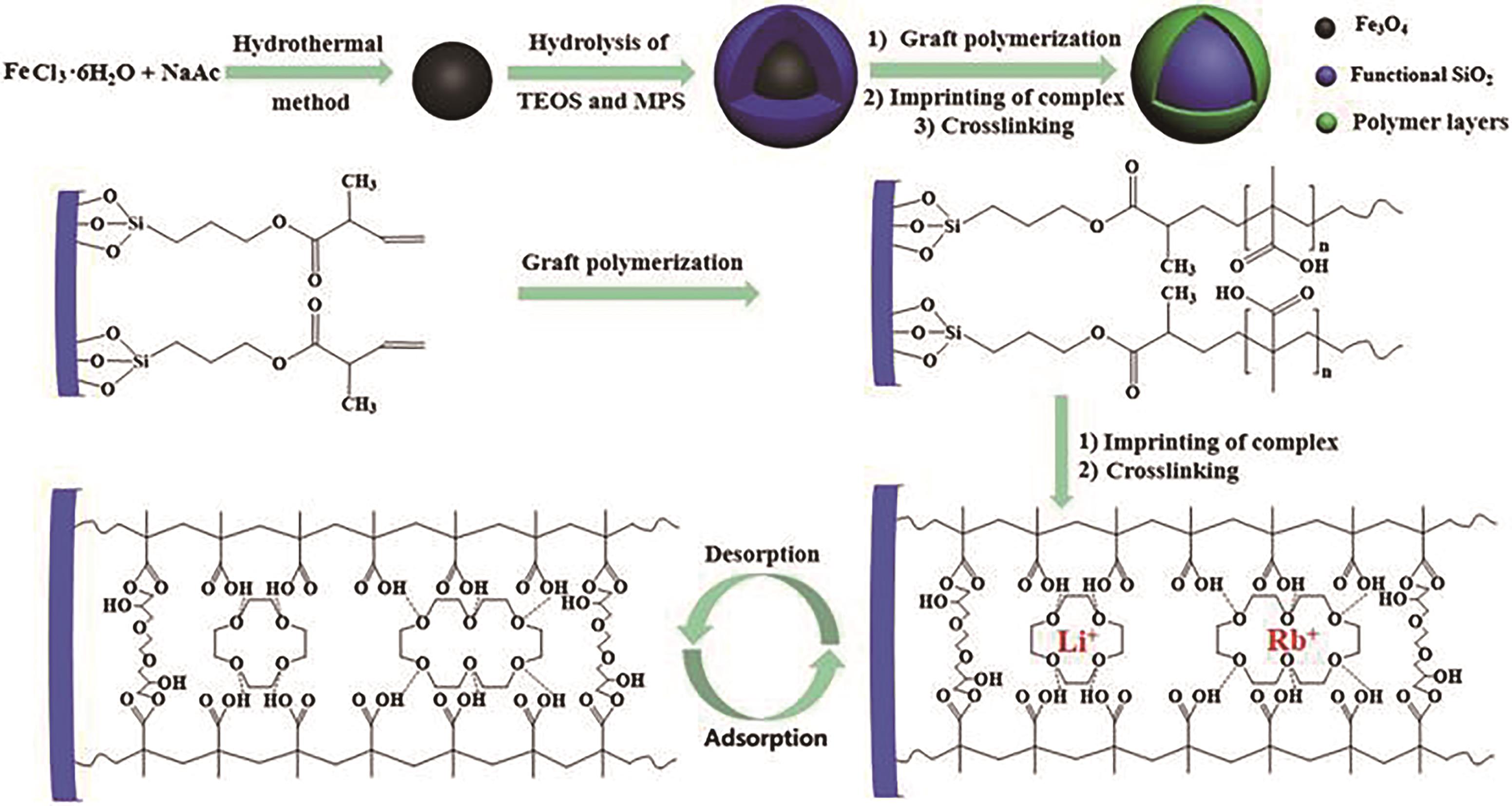
应用化学 ›› 2023, Vol. 40 ›› Issue (1): 24-39.DOI: 10.19894/j.issn.1000-0518.220142
大环化合物在高选择性分子印迹识别体系中的研究进展
- 桂林理工大学化学与生物工程学院,桂林 541006
-
收稿日期:2022-04-19接受日期:2022-09-14出版日期:2023-01-01发布日期:2023-01-28 -
通讯作者:张连明 -
基金资助:广西科技计划项目(No.桂科AD19110059)和广西研究生教育创新计划项目(YCSW2022332)
Research Progress of Macrocyclic Compounds in Highly Selective Molecular Imprinting Recognition System
Jing-Xia GAO, Zi-An WANG, Lian-Ming ZHANG( ), Jian-Ping LI
), Jian-Ping LI
- College of Chemistry and Bioengineering,Guilin University of Technology,Guilin 541006,China
-
Received:2022-04-19Accepted:2022-09-14Published:2023-01-01Online:2023-01-28 -
Contact:Lian-Ming ZHANG -
About author:lianming226@126.com
-
Supported by:the Guangxi Science and Technology Project(Guike AD19110059);the Guangxi Postgraduate Education Innovation Project(YCSW2022332)
摘要:
分子印迹技术(Molecular Imprinting Technology,MIT)因其预定性、专一性和适用性而被广泛应用于色谱分离、固相萃取、药物分析以及手性识别等领域。近些年来,研究者们将大环化合物引入MIT中,在增加识别位点的同时,有效改善了印迹聚合物材料的结构和性能,提高了对模板分子的选择性识别能力。本文重点综述了近10年来环糊精、杯芳烃、柱芳烃、冠醚和葫芦脲等大环化合物在分子印迹技术中的研究进展及应用,并对该领域的发展前景进行了展望。
中图分类号:
引用本文
高静霞, 王子安, 张连明, 李建平. 大环化合物在高选择性分子印迹识别体系中的研究进展[J]. 应用化学, 2023, 40(1): 24-39.
Jing-Xia GAO, Zi-An WANG, Lian-Ming ZHANG, Jian-Ping LI. Research Progress of Macrocyclic Compounds in Highly Selective Molecular Imprinting Recognition System[J]. Chinese Journal of Applied Chemistry, 2023, 40(1): 24-39.
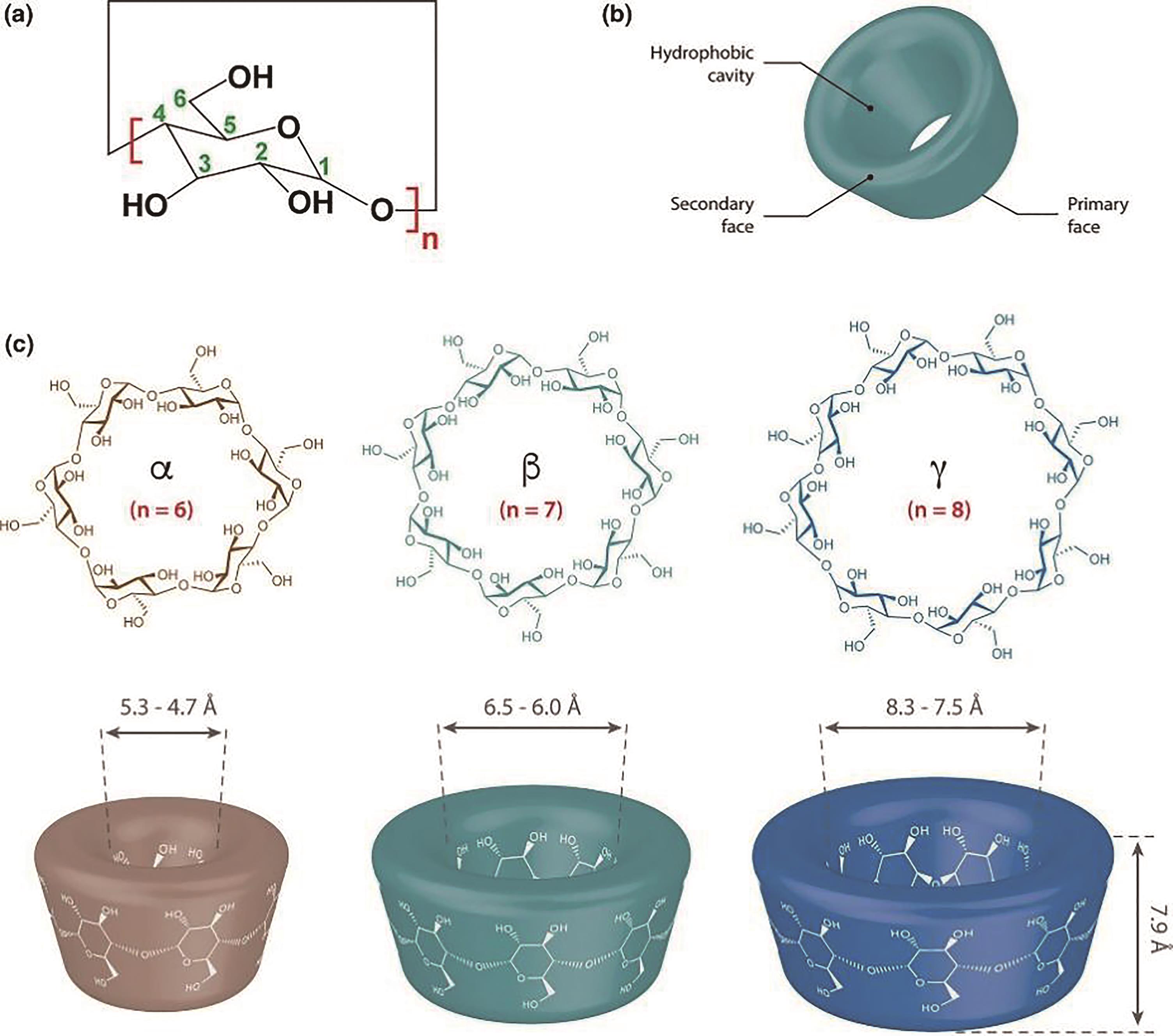
图2 CD的一般化学结构(a)和三维结构的示意图(b),以及α-、 β-和γ-CD的化学结构和尺寸(分别为n=6、7和8)(c)[50]
Fig.2 Schematic representations of the general chemical structure(a), the tridimensional structure of CD (b), and chemical structure and dimensions for α-, β- and γ-CD (n=6, 7 and 8, respectively) (c)[50]

图5 以CD基离子液体为功能单体制备MMIPs用于高选择性和有效富集细胞色素c[64]
Fig.5 Preparation of MMIPs using CD-based ionic liquids as functional monomer for highly selective and effective enrichment of cytochrome c[64]
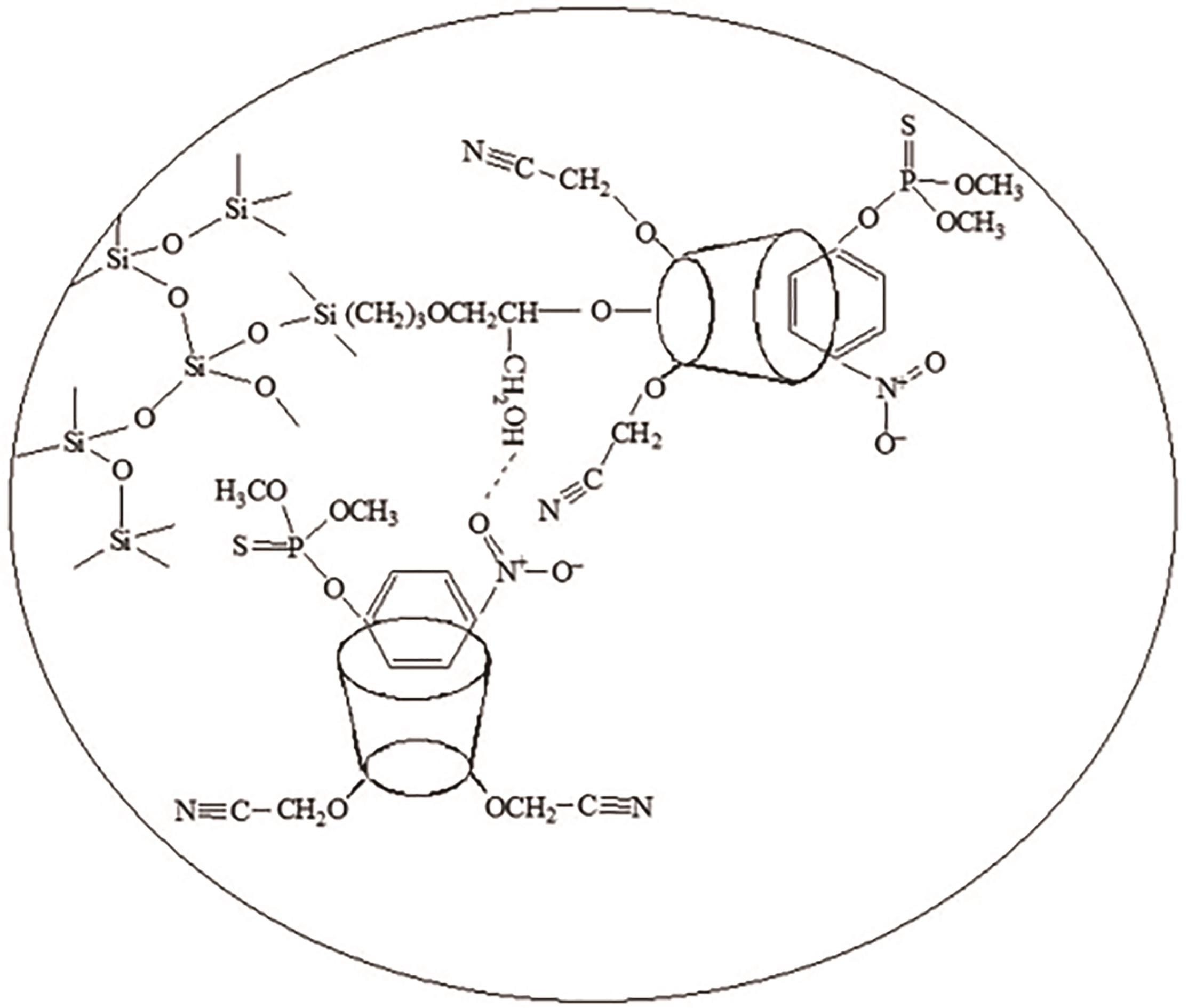
图9 CA分子印迹纤维固相微萃取水果中4种有机磷农药[79]
Fig.9 Molecularly imprinted calixarene fiber for solid-phase microextraction of four organophosphorous pesticides in fruits[79]
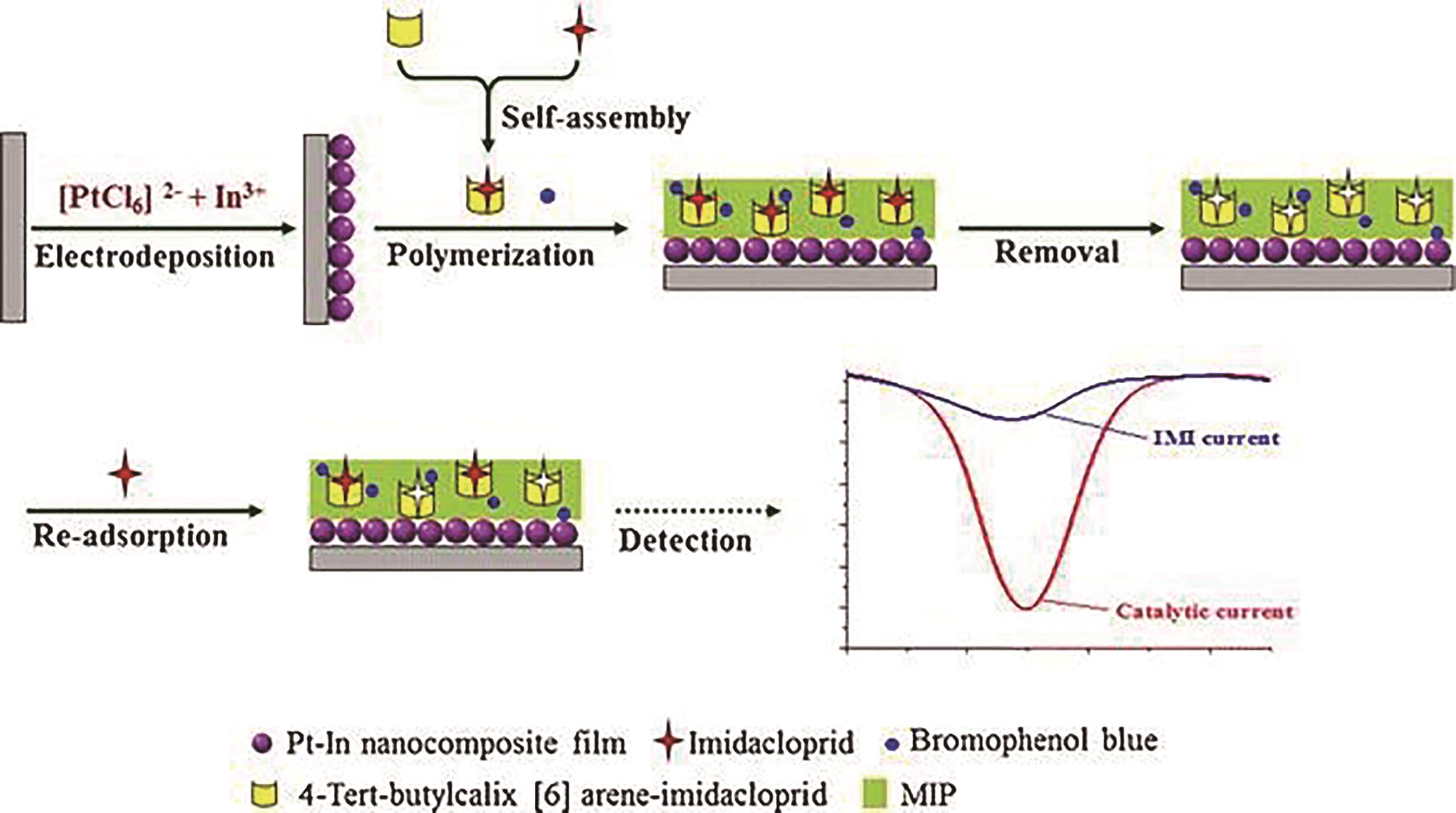
图10 基于Pt-In催化纳米颗粒和溴酚蓝掺杂MIPs膜双放大的新烟碱类杀虫剂吡虫啉超分子印迹电化学传感器[80]
Fig.10 Supramolecular imprinted electrochemical sensor for the neonicotinoid insecticide imidacloprid based on double amplification by Pt-In catalytic nanoparticles and a Bromophenol blue doped molecularly imprinted film[80]

图14 基于12-冠-4和聚醚砜协同作用的高Li+选择性多层IIPs[87]
Fig.14 Multilayered IIPs with high selectivity towards Li+ based on the synergistic effect of 12-crown-4 and polyether sulfone[87]
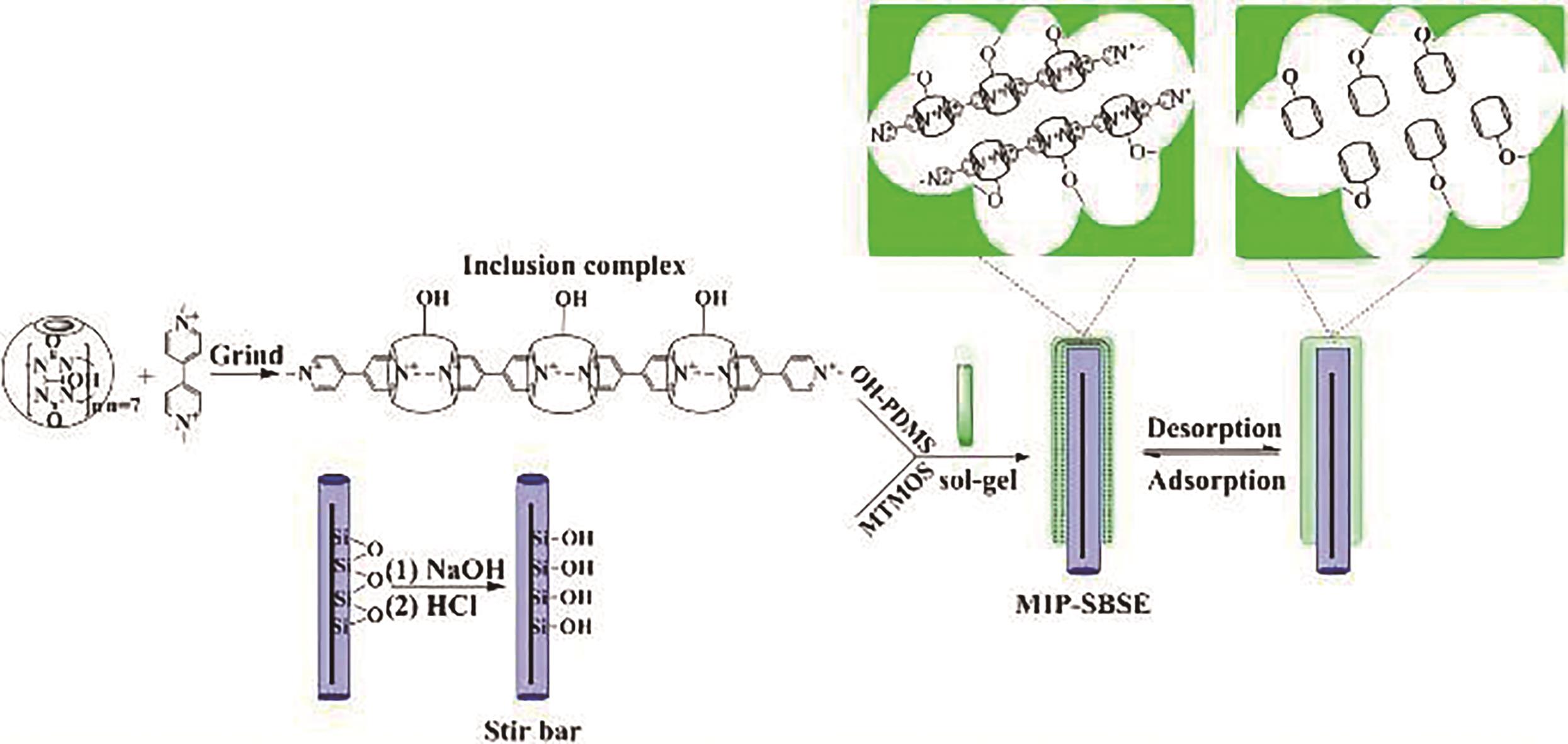
图16 基于单羟基CB[7]尿嘧啶-百草枯复合物的分子印迹搅拌棒特异性吸附环境水和蔬菜样品中的百草枯[96]
Fig.16 Specific recognition of cationic paraquat in environmental water and vegetable samples by molecularly imprinted stir-bar sorptive extraction based on monohydroxylcucurbit[7]uril-paraquat inclusion complex[96]

图17 柱[6]芳烃多层膜:对甲基紫精客体分子的可逆摄取和释放[113]
Fig.17 Pillar[6]arene containing multilayer films: reversible uptake and release of guest molecules with methyl viologen moieties[113]
| Macrocyclic compounds | Application mode | Reported applications | Deficiency |
|---|---|---|---|
| CD | Functional monomer, carrier | Metal ions, steroid molecules, pesticide residues, porphyrins, amino acids, oligopeptides, proteins, etc. | As anion receptors, CD and its derivatives are not easy to directly coated inorganic anions or positively charged receptors. It is difficult to maintain the activity of oligopeptides, proteins and other biological macromolecules in the elution process[ |
| CA | Functional monomer | Acetanilide, α-tocopherol, L-dopa and other chiral drugs, organic phosphorus pesticides such as methyl parathion and imidacloprid etc. | Because the structure of CA is wide at the top and narrow at the bottom, molecules are easy to fall off in the recognition process, and CA has poor water solubility[ |
| CE | Functional monomer,Assisted recognition unit | K+, Rb+, Li+ and other alkali metal ions. | CE does not bind to anions. Due to the size of ring structure, CE is difficult to be applied to molecular recognition[ |
| CB | Functional monomer | Paraquat, melamine, quaternary ammonium salt and other pesticide molecules | CB has poor solubility and strong structural rigidity, so it cannot change its shape to suit the guest molecules. The separation and purification of CB[n] is very difficult and not easy to be functionalized[ |
| PA | Assisted recognition unit | Methylviologen, 2-naphthoic acid pyrene, etc. | PA molecule has electron-rich cavity, highly symmetrical structure and strong rigidity[ |
表1 大环化合物在MIT中的应用
Table 1 Application of macrocyclic compounds in MIT
| Macrocyclic compounds | Application mode | Reported applications | Deficiency |
|---|---|---|---|
| CD | Functional monomer, carrier | Metal ions, steroid molecules, pesticide residues, porphyrins, amino acids, oligopeptides, proteins, etc. | As anion receptors, CD and its derivatives are not easy to directly coated inorganic anions or positively charged receptors. It is difficult to maintain the activity of oligopeptides, proteins and other biological macromolecules in the elution process[ |
| CA | Functional monomer | Acetanilide, α-tocopherol, L-dopa and other chiral drugs, organic phosphorus pesticides such as methyl parathion and imidacloprid etc. | Because the structure of CA is wide at the top and narrow at the bottom, molecules are easy to fall off in the recognition process, and CA has poor water solubility[ |
| CE | Functional monomer,Assisted recognition unit | K+, Rb+, Li+ and other alkali metal ions. | CE does not bind to anions. Due to the size of ring structure, CE is difficult to be applied to molecular recognition[ |
| CB | Functional monomer | Paraquat, melamine, quaternary ammonium salt and other pesticide molecules | CB has poor solubility and strong structural rigidity, so it cannot change its shape to suit the guest molecules. The separation and purification of CB[n] is very difficult and not easy to be functionalized[ |
| PA | Assisted recognition unit | Methylviologen, 2-naphthoic acid pyrene, etc. | PA molecule has electron-rich cavity, highly symmetrical structure and strong rigidity[ |
| 1 | WULFF G, SARHAN A. The use of polymers with enzyme-analogous structures for the resolution of racemates[J]. Angew Chem Int Ed, 1972, 11: 341-346. |
| 2 | VlATAKIS G, ANDERSSON L I, MVLLERR R, et al. Drug assay using antibody mimics made by molecular imprinting[J]. Nature, 1993, 361(6413): 645-647. |
| 3 | ERDOSSY J, HORVATH V, YARMAN A, et al. Electrosynthesized molecularly imprinted polymers for protein recognition[J]. TrAC, Trends Anal Chem, 2016, 79: 179-190. |
| 4 | XU J J, MEDINA-RANGLE P X, HAUPT K, et al. Guide to the preparation of molecularly imprinted polymer nanoparticles for protein recognition by solid-phase synthesis[J]. Methods Enzymol, 2017, 590: 115-141. |
| 5 | LI W, ZHANG Q, WANG Y, et al. Controllably prepared aptamer-molecularly imprinted polymer hybrid for high-specificity and high-affinity recognition of target proteins[J]. Anal Chem, 2019, 91(7): 4831-4837. |
| 6 | MIER A, MAFFUCCI I, MERLIER F, et al. Molecularly imprinted polymer nanogelsforprotein recognition: direct proof of specific binding sites by solution STD and water LOGSY NMR spectroscopies[J]. Angew Chem Int Ed, 2021, 60(38): 20849-20857. |
| 7 | ZHAO C, LU W Z, MENG X Y. Using chiral magnetic surface molecularly imprinted polymers for chiral separation of Ofloxacin[J]. J Polym Res, 2021, 28(6): 1-8. |
| 8 | DERAZSHAMSHIR A, GOKTURK I, YILMAZ F, et al. S-citalopram imprinted monolithic columns for capillary electrochromatography enantioseparations[J]. Electrophoresis, 2021, 42(24): 2672-2682. |
| 9 | ALHAWITIl A S, MONIER M, ELSAYED N H. Designing of amino functionalized imprinted polymeric resin for enantio-separation of (±)-mandelic acid racemate[J]. React Funct Polym, 2021, 160: 104828. |
| 10 | LOU X Y, SONG N, YANG Y W. Fluorescence resonance energy transfer systems in supramolecular macrocyclic chemistry[J]. Molecules, 2017, 22(10): 1640. |
| 11 | ZHANG L M, LUO K, LI D, et al. Chiral molecular imprinted sensor for highly selective determination of D-carnitine in enantiomers via dsDNA-assisted conformation immobilization[J]. Anal Chim Acta, 2020, 1136:82 -90. |
| 12 | LIU J, ZHANG Y, JIANG M, et al. Electrochemical microfluidic chip based on molecular imprinting technique applied for therapeutic drug monitoring[J]. Biosens Bioelectron, 2017, 91: 714-720. |
| 13 | ANSARI S, KARIMI M. Novel developments and trends of analytical methods for drug analysis in biological and environmental samples by molecularly imprinted polymers[J]. TrAC, Trends Anal Chem, 2017, 89: 146-162. |
| 14 | LIN F, TIAN Y S, LOU D D, et al. Catalytic gold-platinum alloy nanoparticles and a novel glucose oxidase mimic with enhanced activity and selectivity constructed by molecular imprinting[J]. Anal Methods, 2019, 11(36): 4586-4592. |
| 15 | LI J P, ZHANG L M, FU C. The recognizing mechanism and selectivity of the molecularly imprinting membrane[J]. Mol Imprinted Catal, 2016: 159-182. |
| 16 | CHEN T, WEI S, CHENG Z F, et al. Specific detection of monosaccharide by dual-channel sensing platform based on dual catalytic system constructed by bio-enzyme and bionic enzyme using molecular imprinting polymers[J]. Sens Actuators B: Chem, 2020, 320: 128430. |
| 17 | ZHANG L M, ZHANG D Y, YING Z, et al. A cimaterol molecularly imprinted sensor based on DNA-assisted recognition[J]. Chin J Anal Chem, 2018, 46(11): 1770-1777. |
| 18 | TARANNUM N, HENDRICKSON O D, KHATOON S, et al. Molecularly imprinted polymers as receptors for assays of antibiotics[J]. Crit Rev Anal Chem, 2020, 50(4): 291-310. |
| 19 | WANG M C, WANG Y, QIAO Y, et al. High-sensitive imprinted membranes based on surface-enhanced Raman scattering for selective detection of antibiotics in water[J]. Spectrochim Acta,Part A, 2019, 222: 117116. |
| 20 | LI J P, LI Y P, ZHANG Y, et al. Highly sensitive molecularly imprinted electrochemical sensor based on the double amplification by an inorganic prussian blue catalytic polymer and the enzymatic effect of glucose oxidase[J]. Anal Chem, 2012, 84(4): 1888-1893. |
| 21 | LEHN J M. Supramolecular chemistry-scope and perspectives molecules, supermolecules, and molecular devices (Nobel Lecture)[J]. Angew Chem Int Ed, 1988, 27(1): 89-112. |
| 22 | PAUL R, PAUL S. Synergistic host-guest hydrophobic and hydrogen bonding interactions in the complexation between endo-functionalized molecular tube and strongly hydrophilic guest molecules in aqueous solution[J]. Phys Chem Chem Phys, 2018, 20(24): 16540-16550. |
| 23 | ZHOU Y, JIE K, ZHAO R, et al. Supramolecular-macrocycle-based crystalline organic materials[J]. Adv Mater, 2020, 32(20): 1904824. |
| 24 | DONG S Y, GAO L Y, CHEN J Z, et al. A supramolecular polymer formed by the combination of crown ether-based and charge-transfer molecular recognition[J]. Polym Chem, 2013, 4(4): 882-886. |
| 25 | GE Z S, H J M, HUANG F H, et al. Responsive supramolecular gels constructed by crown ether based molecular recognition[J]. Chem Soc Rev, 2005, 34: 821-836. |
| 26 | HARADA A, TAKASHIMA Y, NAKAHATA M. Supramolecular polymeric materials via cyclodextrin-guest interactions[J]. Acc Chem Res, 2014, 47(7): 2128-2140. |
| 27 | ZHANG Y M, XU Q Y, LIU Y. Molecular recognition and biological application of modified β-cyclodextrins[J]. China Chem, 2019, 62: 549-560. |
| 28 | NAKAHATA M, TAKASHIMA Y, HARADA A. Supramolecular polymeric materials containing cyclodextrins[J]. Chem Pharm Bull, 2017, 65(4): 330-335. |
| 29 | 吉晓帆, 夏丹玉, 颜徐州, 等. 基于冠醚和柱芳烃主客体识别的超分子聚合物材料[J]. 高分子学报, 2017(1): 9-17. |
| JI X F, XIA D Y, YAN X Z, et al. Supramolecular polymer materials based on host-guest recognition of crown ethers and pillar arenes[J]. Acta Polym Sin, 2017(1): 9-17. | |
| 30 | BARROW S J, KASERA S, ROWLAND M J, et al. Cucurbituril-based molecular recognition[J]. Chem Rev, 2015, 115(22): 12320-12406. |
| 31 | LI P Y, CHEN Y, LIU Y. Calixarene/pillararene-based supramolecular selective binding and molecular assembly[J]. Lett, 2019, 30(6): 1190-1197. |
| 32 | LIU Z, DAI X Y, SUN Y H, et al. Organic supramolecular aggregates based on water-soluble cyclodextrins and calixarenes[J]. Aggregate, 2020, 1(1): 31-44. |
| 33 | YOU L, ZHA D, ANSLYN E V. Recent advances in supramolecular analytical chemistry using optical sensing[J]. Chem Rev, 2015, 115(15): 7840-7892. |
| 34 | CICOLANI R S, SOUZA L R R, DE SANTANA DIAS G B, et al. Cucurbiturils for environmental and analytical chemistry[J]. J Inclusion Phenom Macrocyclic Chem, 2021, 99(1): 1-12. |
| 35 | ZHOU J, LI J, DU X W, et al. Supramolecular biofunctional materials[J]. Biomaterials, 2017, 129: 1-27. |
| 36 | WANG L, CHENG L, LI G, et al. A self-cross-linking supramolecular polymer network enabled by crown-ether-based molecular recognition[J]. J Am Chem Soc, 2020, 142(4): 2051-2058. |
| 37 | DONG S Y, ZHENG B, WANG F, et al. Supramolecular polymers constructed from macrocycle-based host-guest molecular recognition motifs[J]. Acc Chem Res, 2014, 47(7): 1982-1994. |
| 38 | GUS’KOV V Y, MAISTRENKO V. New chiral stationary phases: preparation, properties, and applications in gas chromatography[J]. J Anal Chem, 2018, 73(10): 937-945. |
| 39 | SUN T, LI B, SHUAI X, et al. Performance and selectivity of lower-rim substituted calix[4]arene as a stationary phase for capillary gas chromatography[J]. RSC Adv, 2019, 9(37): 21207-21214. |
| 40 | GAI Y Y, LIANG S, CHEN W, et al. Practical evaluation of chitosan-based chiral stationary phase for pharmaceutical analysis by high-performance liquid chromatography[J]. Chromatographia, 2022, 85: 247-254. |
| 41 | CHEN W, JIANG J Z, QIU G S, et al. The interactions between chiral analytes and chitosan-based chiral stationary phases during enantioseparation[J]. J Chromatogr A, 2021, 1650: 462259. |
| 42 | SUN Y, LI C, NIU X Y, et al. Rapid and mild fabrication of protein membrane coated capillary based on supramolecular assemble for chiral separation in capillary electrochromatography[J]. Talanta, 2019, 195: 190-196. |
| 43 | LAY S, NI X F, YU H N et al. State-of-the-art applications of cyclodextrins as functional monomers in molecular imprinting techniques: a review[J]. J Sep Sci, 2016, 39(12): 2321-2331. |
| 44 | LIANG X, LIANG W, JIN P, et al. Advances in chirality sensing with macrocyclic molecules[J]. Chemosensors, 2021, 9(10): 279. |
| 45 | LI J P, WEI G, ZHANG Y. Molecularly imprinted polymers as recognition elements in sensors[J]. Mol Imprinted Sens, 2012: 35-55. |
| 46 | YANG B, FU C, LI J P, et al. Frontiers in highly sensitive molecularly imprinted electrochemical sensors: challenges and strategies[J]. Trends Anal Chem, 2018, 105: 52-67. |
| 47 | LI S H, LI J P, MA X H, et al. Highly selective molecular imprinting electrochemiluminescence switch sensor for biotoxin L-canavanine measurement[J]. Microchem J, 2019, 148: 397-403. |
| 48 | LI D, LUO K, ZHANG L M, et al. Research and application of highly selective molecular imprinting technology in chiral separation analysis[J]. Crit Rev Anal Chem, 2021: 1-14. |
| 49 | WANG Y, SUN Y W, BIAN H, et al. Cyclodextrin porous liquid materials for efficient chiral recognition and separation of nucleosides[J]. ACS Appl Mater Interfaces, 2020, 12(41): 45916-45928. |
| 50 | CRINI G, FOURMENTIN S, FENVVESI É, et al. Cyclodextrins, from molecules to applications[J]. Environ Chem Lett, 2018, 16(4): 1361-1375. |
| 51 | SREENIVASAN K. Synthesis and evaluation of a beta cyclodextrin-based molecularly imprinted copolymer[J]. J Appl Polym Sci, 1998, 70(1): 15-18. |
| 52 | ZHAO X Y, WANG Y, ZHANG P, et al. Recent advances of molecularly imprinted polymers based on cyclodextrin[J]. Macromol Rapid Commun, 2021, 42(9): 2100004. |
| 53 | LIU Y C, LIU Y J, LIU Z M, et al. Supramolecularly imprinted polymeric solid phase microextraction coatings for synergetic recognition nitrophenols and bisphenol A[J]. J Hazard Mater, 2019, 368: 358-364. |
| 54 | HUANG D L, TANG Z H, PENG Z W, et al. Fabrication of water-compatible molecularly imprinted polymer based on β-cyclodextrin modified magnetic chitosan and its application for selective removal of bisphenol A from aqueous solution[J]. J Taiwan Inst Chem Eng, 2017, 77: 113-121. |
| 55 | FAROOQ S, NIE J Y, CHENG Y, et al. Selective extraction of fungicide carbendazim in fruits using β-cyclodextrin based molecularly imprinted polymers[J]. J Sep Sci, 2020, 43(6): 1145-1153. |
| 56 | XU Z F, WEN G, KUANG D Z, et al. Selective separation of deltamethrin by molecularly imprinted polymers using a β-cyclodextrin derivative as the functional monomer[J]. J Environmental Sci Health, Part B, 2013, 48(5): 336-343. |
| 57 | ZHAO L, WANG X L, MA L, et al. Improving affinity of β-cyclodextrin-based molecularly imprinted polymer using room temperature ionic liquid[J]. Eur Polym J, 2019, 116: 275-282. |
| 58 | LIU Y C, LIU Y J, LIU Z M, et al. β-Cyclodextrin molecularly imprinted solid-phase microextraction coatings for selective recognition of polychlorophenols in water samples[J]. Anal Bioanal Chem, 2018, 410(2): 509-519. |
| 59 | DOLAI J, ALI H, JANA N R. Molecular imprinted poly-cyclodextrin for selective removal of dibutyl phthalate[J]. ACS Appl Polym Mater, 2019, 2(2): 691-698. |
| 60 | WANG C, DING C, WU Q, et al. Molecularly imprinted polymers with dual template and bifunctional monomers for selective and simultaneous solid-phase extraction and gas chromatographic determination of four plant growth regulators in plant-derived tissues and foods[J]. Food Anal Methods, 2019, 12(5): 1160-1169. |
| 61 | ZHANG L, HE L, WANG Q, et al. Theoretical and experimental studies of a novel electrochemical sensor based on molecularly imprinted polymer and GQDs-PtNPs nanocomposite[J]. Microchem J, 2020, 158: 105196. |
| 62 | GUO H Q, XIONG J J, MA W T, et al. Synthesis of molecularly imprinted polymers using acrylamide-beta-cyclodextrin as a cofunctional monomer for the specific capture of tea saponins from the defatted cake extract of Camellia oleifera[J]. J Sep Sci, 2016, 39(22): 4439-4448. |
| 63 | LAY S, YU H N, HU B X, et al. Molecularly imprinted polymers as the extracted sorbents of clenbuterol ahead of liquid chromatographic determination[J]. Zhejiang Univ Sci, 2016, 17(6): 465-475. |
| 64 | ZHANG X, ZHANG N, DU C, et al. Preparation of magnetic epitope imprinted polymer microspheres using cyclodextrin-based ionic liquids as functional monomer for highly selective and effective enrichment of cytochrome c[J]. Chem Eng J, 2017, 317: 988-998. |
| 65 | ZHANG P, CHEN G, WANG Z, et al. Design and synthesis of Fe3O4@Au@cyclodextrin-molecularly imprinted polymers labeled with SERS nanotags for ultrasensitive detection of transferrin[J]. Sens Actuators B: Chem, 2022, 361: 131669. |
| 66 | 刘彩萍, 白阳. 环糊精超分子聚合物在药物/基因递送载体领域的研究进展[J]. 化学通报, 2018, 81(4): 326-331, 383. |
| LIU C P, BAI Y. Research progress of cyclodextrinsupramolecular polymers in the field of drug/gene delivery vehicles[J]. Chem Bull, 2018, 81(4): 326-331, 383. | |
| 67 | 张芸, 郭敏杰, 么敬霞, 等. 以环糊精准聚轮烷为 “假载体” 印迹识别蛋白质的研究[J]. 分析化学, 2014, 42(2): 186-191. |
| ZHANG Y, GUO M J, ME J X et al. Research on protein recognition by imprinting using cyclodextrin precise polyrotaxane as “pseudocarrier”[J]. Chin J Anal Chem, 2014, 42(2): 186-191. | |
| 68 | 代国飞, 王明伟. 环糊精及其衍生物的药学应用进展[J]. 中国新药杂志, 2005, 14(11): 1261-1264. |
| DAI G F, WANG M W. Advances in pharmaceutical application of cyclodextrin and its derivatives[J]. Chin J New Drug, 2005, 14(11): 1261-1264. | |
| 69 | HE X Y, WANG Y Z, LI H, et al. Specific recognition of protein by deep eutectic solvent-based magnetic β-cyclodextrin molecularly imprinted polymer[J]. Microchim Acta, 2021, 188(7): 1-9. |
| 70 | TROTTA F, CALDRA F, CAVALLI R, et al. Molecularly imprinted cyclodextrinnanosponges for the controlled delivery of L-DOPA: perspectives for the treatment of Parkinson's disease[J]. Expert Opin Drug Delivery, 2016, 13(12): 1671-1680. |
| 71 | JURIC D, ROHNER N A, VON RECUM H A. Molecular imprinting of cyclodextrinsupramolecular hydrogels improves drug loading and delivery[J]. Macromol Biosci, 2019, 19(1): 1800246. |
| 72 | BASILOTTA R, MANNINO D, FILIPPONE A, et al. Role of calixarene in chemotherapy delivery strategies[J]. Molecules, 2021, 26(13): 3963. |
| 73 | CHEN C F, HAN Y. Triptycene-derived macrocyclicarenes: from calixarenes to helicarenes[J]. Acc Chem Res, 2018, 51(9): 2093-2106. |
| 74 | 曹丙庆, 潘勇, 赵建军, 等. 对-叔丁基杯[4]芳烃衍生物自组装分子在声表面波传感器中检测有机磷[J]. 应用化学, 2008, 25(10): 1176-118 |
| CAO B Q, PAN Y, ZHAO J J, et al. Detection of organophosphorus compounds by surface acoustic wave sensor with p-tertbutylcalix[4]arene self-assembly coatings[J]. Chin J Appl Chem, 2008, 25(10): 1176-1180. | |
| 75 | YANG B J, CAO X J. Synthesis of the artemisinin-imprinting polymers on silica surface and its adsorption behavior in supercritical CO2 fluid[J]. AIChE J, 2011, 57(12): 3514-3521. |
| 76 | YILMAZ M, ERDEMIR S. Calixarene-based receptors for molecular recognition[J]. Turk J Chem, 2013, 37(4): 558-585. |
| 77 | LI C Y, WANG C F, GUAN B, et al. Electrochemical sensor for the determination of parathion based on p-tert-butylcalix[6]arene-1,4-crown-4 sol-gel film and its characterization by electrochemical methods[J]. Sens Actuators B: Chem, 2005, 107(1): 411-417. |
| 78 | 潘勇, 何世堂, 林涛, 等. 间苯二酚杯[4]芳烃硫醚衍生物SAW分子印迹膜的合成[J]. 化学传感器, 2010, 30(3): 48-53. |
| PAN Y, HE S T, LIN T, et al. Synthesis of SAW molecularly imprinted membrane of resorcinol calix[4]arenethioether derivatives[J]. Chem Sens, 2010, 30(3): 48-53. | |
| 79 | LI J W, WANG Y L, YAN S, et al. Molecularly imprinted calixarene fiber for solid-phase microextraction of four organophosphorous pesticides in fruits [J]. Food Chem, 2016, 192: 260-267. |
| 80 | LI S, LIU C, YIN G. et al. Supramolecular imprinted electrochemical sensor for the neonicotinoid insecticide imidacloprid based on double amplification by Pt-In catalytic nanoparticles and a Bromophenol blue doped molecularly imprinted film[J]. Microchim Acta, 2016, 183: 3101-3109. |
| 81 | LU C Y, HE H C, HE X W, et al. Molecularly imprinted polymer with calix[4]arene derivative for the recognition of acetanilide[J]. Chin J Chem, 2004, 22(3): 275-278. |
| 82 | NICOI F, BARONCINI M, SILVI S, et al. Direct synthetic routes to functionalised crown ethers[J]. Org Chem Front, 2021, 8(19): 5531-5549. |
| 83 | LUO H, CHEN L X, GE Q M, et al. Applications of macrocyclic compounds for electrochemical sensors to improve selectivity and sensitivity[J]. J Inclusion Phenom Macrocyclic Chem, 2019, 95(3): 171-198. |
| 84 | ANDERSSON H S, RAMSTROM O. Crown ethers as a tool for the preparation of molecularly imprinted polymers[J]. J Mol Recognit: An Interdisciplinary J, 1998, 11(1/6): 103-106. |
| 85 | RAJABI H R, SHAMSIPUR M, POURMORTAZAVI S M. Preparation of a novel potassium ion imprinted polymeric nanoparticles based on dicyclohexyl 18C6 for selective determination of K+ ion in different water samples[J]. Mater Sci Eng C, 2013, 33(6): 3374-3381. |
| 86 | LUO X B, LIU L L, DENG F, et al. Novel ion-imprinted polymer using crown ether as a functional monomer for selective removal of Pb(II) ions in real environmental water samples[J]. J Mater Chem A, 2013, 1(28): 8280-8286. |
| 87 | XU J C, PU Z L, XU X C, et al. Simultaneous adsorption of Li(I) and Rb(I) by dual crown ethers modified magnetic ion imprinting polymers[J]. Appl Organomet Chem, 2019, 33(3): e4778. |
| 88 | ZHOU Z Y, HU Y L, WANG Z, et al. Facile preparation of a rubidium ion-imprinted polymer by bulk polymerization for highly efficient separation of rubidium ions from aqueous solution[J]. New J Chem, 2021, 45(21): 9582-9590. |
| 89 | LIANG Q, ZHANG E H, YAN G, et al. A lithium ion-imprinted adsorbent using magnetic carbon nanospheres as a support for the selective recovery of lithium ions[J]. New Carbon Mater, 2020, 35(6): 696-706. |
| 90 | JIANG C Y, FANG M, HUANG A, et al. Fabrication of novel magnetic rubidium ion-imprinted polymer for the selective separation[J]. New J Chem, 2022: 46: 6343-6352 |
| 91 | SHAO H, LI C, MA C, et al. An ion-imprinted material embedded carbon quantum dots for selective fluorometric determination of lithium ion in water samples[J]. Microchim Acta, 2017, 184(12): 4861-4868. |
| 92 | LIU W F, YAN G, ZHANG E, et al. Extraction of lithium ions from acidic solution using electrochemically imprinted membrane[J]. Desalination, 2020, 496: 114751. |
| 93 | LEE J W, SAMAL S, SELVAPALAM N, et al. Cucurbituril homologues and derivatives: new opportunities in supramolecular chemistry[J]. Acc Chem Res, 2003, 36(8): 621-630. |
| 94 | SONG Z, ZHAI X, JIANG C, et al. Sensitive and selective detection of carbamazepine in serum samples by bionic double-antibody sandwich method based on cucurbit[7]uril and molecular imprinted polymers[J]. Biosens Bioelectron, 2022, 203: 114037. |
| 95 | KUSHWAHA S, SUSHAKAR P P. Noncovalent surface grafting of uranium complexedcucurbit[5]uril oligomer onto palm shell powder: a novel approach for selective uranyl ion extraction[J]. Analyst, 2012, 137(14): 3242-3245. |
| 96 | YAO J, ZHANG L, RAN J, et al. Specific recognition of cationic paraquat in environmental water and vegetable samples by molecularly imprinted stir-bar sorptive extraction based on monohydroxylcucurbit[7]uril-paraquat inclusion complex[J]. Microchim Acta, 2020, 187(10): 1-10. |
| 97 | HENNING N, YUAN B, ZHANG J W, et al. Cucurbit[8]uril as nanocontainer in a polyelectrolyte multilayer film: a quantitative and kinetic study of guest uptake[J]. Langmuir, 2015, 31(39): 10734-10742. |
| 98 | XUE M, YANG Y, CHI X, et al. Pillararenes, a new class of macrocycles for supramolecular chemistry[J]. Acc Chem Res, 2012, 45(8): 1294-1308. |
| 99 | OGOSHI T, KANAI S, FUJINAMI S, et al. Para-bridged symmetrical pillar[5]arenes: their Lewis acid catalyzed synthesis and host-guest property[J]. J Am Chem Soc, 2008, 130(15): 5022-5023. |
| 100 | YAKIMOVA L S, SHURPIK D N, GURALNIK E G, et al. Fluorescein-loaded solid lipid nanoparticles based on monoamine Pillar[5]arene: synthesis and interaction with DNA[J]. Chem Nano Mat, 2018, 4(9): 919-923. |
| 101 | LIN W, ZHOU X, CAI J, et al. Anion-functionalized pillararenes for efficient sulfur dioxide capture: significant effect of the anion and the cavity[J]. Chem-Eur J, 2017, 23(57): 14143-14148. |
| 102 | DAI D, LI Z, YANG J, et al. Supramolecular assembly-induced emission enhancement for efficient mercury(II) detection and removal[J]. J Am Chem Soc, 2019, 141(11): 4756-4763. |
| 103 | YAO Q, LV B, JI C, et al. Supramolecular host-guest system as ratiometric Fe3+ ion sensor based on water-soluble pillar[5]arene[J]. ACS Appl Mater Interface, 2017, 9(41): 36320-36326. |
| 104 | CHEN J F, CHENG X B, LI H, et al. A copillar[5]arene-based fluorescence “on-off-on” sensor is applied in sequential recognition of an iron cation and a fluoride anion[J]. New J Chem, 2017, 41(5): 2148-2153. |
| 105 | GUO D S, LIU Y. Calixarene-based supramolecular polymerization in solution[J]. Chem Soc Rev, 2012, 41(18): 5907-5921. |
| 106 | SUN J F, HUA B, LI Q, et al. Acid/base-controllable fret and self-assembling systems fabricated by rhodamine B functionalized pillar[5]arene-based host-guest recognition motifs[J].Org Lett, 2018, 20(2): 365-368. |
| 107 | CHEN J F, LIN Q, ZHANG Y M, et al. Pillararene-based fluorescent chemosensors: recent advances and perspectives[J]. Chem Commun, 2017, 53(100): 13296-13311. |
| 108 | HOU X, LIU X, LI Z, et al. Electrochemical determination of methyl parathion based on pillar[5]arene@AuNPs@ reduced graphene oxide hybrid nanomaterials[J]. New J Chem, 2019, 43(33): 13048-13057. |
| 109 | ZHANG F, MA J K, SUN Y, et al. Construction of a switchable nanochannel for protein transport via a pillar[5]arene-based host-guest system[J]. Anal Chem, 2018, 90(13): 8270-8275. |
| 110 | LIU X, SHAO W, ZHENG Y J, et al. GSH-responsive supramolecular nanoparticles constructed by β-D-galactose-modified pillar[5]arene and camptothecinprodrug for targeted anticancer drug delivery[J]. Chem Commun, 2017, 53(61): 8596-8599. |
| 111 | GUO F, XIA T, XIAO P, et al. A supramolecular complex of hydrazide-pillar[5]arene and bisdemethoxycurcumin with potential anti-cancer activity[J]. Bioorg Chem, 2021, 110: 104764. |
| 112 | LI B, LI S, WANG B, et al. Capture of sulfur mustard by pillar[5]arene: from host-guest complexation to efficient adsorption using nonporous adaptive crystals[J]. Iscience, 2020, 23(9): 101443. |
| 113 | YUAN B, XU J F, SUN C L, et al. Pillar[6]arene containing multilayer films: reversible uptake and release of guest molecules with methyl viologen moieties[J]. ACS Appl Mater Interfaces, 2016, 8(6): 3679-3685. |
| 114 | MONTES-GARCIA V, GOMEZ-GONZALEZ B, MARTINEZ-SOLIS D, et al. Pillar[5]arene-based supramolecularplasmonic thin films for label-free, quantitative and multiplex SERS detection[J]. ACS Appl Mater Interfaces, 2017, 9(31): 26372-26382. |
| 115 | ZHAO W, LI B, XU S, et al. A fabrication strategy for protein sensors based on an electroactive molecularly imprinted polymer: cases of bovine serum albumin and trypsin sensing[J]. Anal Chim Acta, 2020, 1117: 25-34. |
| 116 | LI S H, PANG C H, MA X H, et al. Chiral drug fluorometry based on a calix[6]arene/molecularly imprinted polymer double recognition element grafted on nano-C-dots/Ir/Au[J].Microchim Acta, 2020, 187(7): 1-8. |
| 117 | FAIZAL C K M, KIKUCHI Y, KOBAYASHI T. Molecular imprinting targeted for α-tocopherol by calix[4]resorcarenes derivative in membrane scaffold prepared by phase inversion[J]. J Membr Sci, 2009, 334(1/2): 110-116. |
| 118 | HUANG Y, WANG R. Green recovery of lithium from water by a smart imprinted adsorbent with photo-controlled and selective properties[J]. Chem Eng J, 2019, 378: 122084 |
| 119 | HASHEMI B, SHAMSIPUR M. Synthesis of novel ion-imprinted polymeric nanoparticles based on dibenzo-21-crown-7 for the selective pre-concentration and recognition of rubidium ions[J]. J Sep Sci, 2015, 38(24): 4248-4254. |
| 120 | LUO X, GUO B, LUO J, et al. Recovery of lithium from wastewater using development of Li ion-imprinted polymers[J]. ACS Sustainable Chem Eng, 2015, 3(3): 460-467. |
| [1] | 伍凡, 田贺元, 刘鹏, 孙立伟, 张一波, 杨向光. 高氧空位尖晶石型锰基催化剂用于低温NH3-SCR反应[J]. 应用化学, 2023, 40(5): 697-707. |
| [2] | 林锦, 王芳珠, 吕灵灵. 工业原料制备大孔拟薄水铝石及在异佛尔酮选择性加氢中的应用[J]. 应用化学, 2023, 40(1): 79-90. |
| [3] | 郭佳昕, 刘洋, 徐长山, 刘晓男, 程亮. 不同pH值下MgO NPs悬浮液中Mg2+质量浓度的动态变化及其对小麦生长的影响[J]. 应用化学, 2022, 39(9): 1401-1411. |
| [4] | 张丹, 尚润梅, 赵振涛, 李君华, 邢锦娟. V/Ce-Al2O3催化甲醇选择性氧化制备二甲氧基甲烷[J]. 应用化学, 2022, 39(9): 1429-1436. |
| [5] | 李东东, 秦丽, 唐录华, 高文惠. 碱性橙Ⅱ印迹传感器的制备及其应用[J]. 应用化学, 2022, 39(7): 1052-1064. |
| [6] | 秦丽, 尤晓亭, 唐录华, 李建文, 张寅, 高文惠, 韩俊华. 基于纳米材料修饰的碱性嫩黄O印迹传感器的制备及其应用[J]. 应用化学, 2022, 39(12): 1880-1890. |
| [7] | 唐静, 张娜, 史冬旭, 张芳慧, 唐健杰. UiO-66-NH2接枝吡啶亚胺钴系催化剂的合成及催化乙烯齐聚性能[J]. 应用化学, 2022, 39(02): 258-265. |
| [8] | 刘文彬, 杨莎莎, 黄国林, 樊利娇, 谢宇铭. 磷酸化黄原胶/氧化石墨烯的合成及其对铀的选择性吸附[J]. 应用化学, 2021, 38(6): 658-667. |
| [9] | 谢志琦, 张婷, 李英崴, 王周君, 代飞, 张瑞锐, 刘瑞霞. 钒磷氧合成条件对丁烷选择性氧化催化性能的影响[J]. 应用化学, 2021, 38(4): 414-421. |
| [10] | 魏雪莹, 吴玮, 乃永宁, 姜梦圆, 田诗伟, 毛国梁. 膦胺铬和双膦铬催化乙烯选择性齐聚研究进展[J]. 应用化学, 2021, 38(2): 136-156. |
| [11] | 刘宁, 王丹凤, 伍素云, 刘水林, 付琳, 刘跃进. 短孔道介孔分子筛Zr-Ce-SBA-15固载酸性离子液体催化合成双酚F[J]. 应用化学, 2020, 37(9): 1038-1047. |
| [12] | 姚美任, 王康军, 张雅静, 王东平. 大位阻手性吡咯烷(salen)Mn(III)配合物在烯烃不对称环氧化反应中的应用[J]. 应用化学, 2020, 37(8): 889-895. |
| [13] | 李茂盛, 陈金龙, 陶友华. 氨基酸功能化环辛烯单体的区域及立体选择性开环易位聚合[J]. 应用化学, 2020, 37(3): 280-292. |
| [14] | 曾利辉,李岳锋,延浩翔,曾永康,张之翔,刘忠文,刘昭铁. 贵金属催化p-叔丁基-α-甲基肉桂醛加氢[J]. 应用化学, 2020, 37(3): 322-331. |
| [15] | 刘强, 赵振波, 张弨, 赵凤玉. CuZn/Al2O3催化γ-戊内酯加氢制1,4-戊二醇[J]. 应用化学, 2020, 37(11): 1285-1292. |
| 阅读次数 | ||||||
|
全文 |
|
|||||
|
摘要 |
|
|||||
